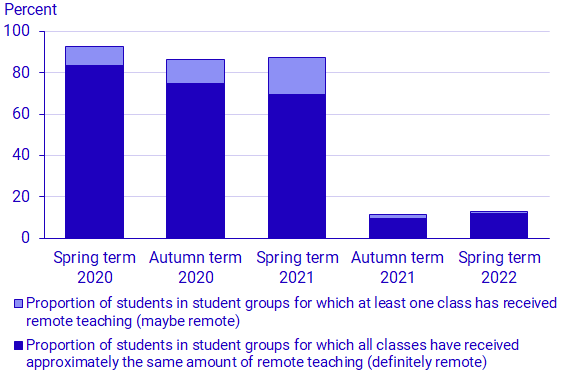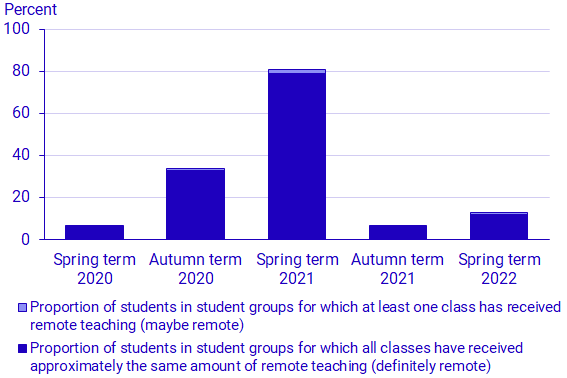Remote teaching (live and non-live) in compulsory school and upper secondary school during the covid-19 pandemic, 2021/22 academic year
Remote teaching decreased substantially in the latter part of the covid-19 pandemic
Statistical news from Statistics Sweden 2023-02-21 8.00
In contrast to the first three terms during the pandemic, few upper secondary school students received remote teaching during the 2021/22 academic year, when the omicron wave was ongoing. In upper-level compulsory school (grades 7–9), even fewer students received remote teaching then, and in the lower age groups there was hardly any.
The volume of remote teaching has varied since the spring term of 2020, both over time and between schools. Transmission rates of covid-19 and the regulations and recommendations to reduce the spread of infection affected the extent to which schools completely or partially switched to remote teaching.
Much less remote teaching in upper secondary schools
During the first three terms of the pandemic (spring term 2020 – spring term 2021), most upper secondary school students received remote teaching to some extent.
“This was not the case during the 2021/22 academic year. Then, 16–18 percent received remote teaching to some extent,” explains Sinisa Sauli, analyst at Statistics Sweden.

Most remote teaching took place in the spring term of 2020. Upper secondary school students who received remote teaching had it on average (median and converted to full-time) for
- 12 weeks in the spring term of 2020
- 3 weeks in the autumn term of 2020
- 7 weeks in the spring term of 2021
- 2 weeks in the autumn term of 2021
- 2 weeks in the spring term of 2022.
Same amount of remote teaching in upper-level compulsory school as at the beginning of the pandemic
In lower-level (grades 1–3) and mid-level (grades 4–6) compulsory school, it was unusual in 2021/22 for whole classes or grade years to have remote teaching due to covid-19 transmission rates. The proportion of upper-level (grades 7–9) compulsory school students who received remote teaching to some extent was 15–16 percent, which is roughly the same level as during the first term of the pandemic (spring term 2020).

In upper-level compulsory school (grades 7–9), most remote teaching took place in the spring term of 2021. Upper-level compulsory school students who received remote teaching had it on average (median and converted to full-time) for
- 3 weeks in the spring term of 2020
- 1 week in the autumn term of 2020
- 5 weeks in the spring term of 2021
- 1 week in the autumn term of 2021
- 2 weeks in the spring term of 2022.
More findings
The report “Remote teaching (live and non-live) in compulsory school and upper secondary school during the covid-19 pandemic” also includes findings that show:
- how the schools have organised remote teaching.
- exemptions from remote teaching for individual students.
- the extent to which the students received help with computer access and internet connection when teaching was remote
- remote teaching when students were absent due to mild symptoms of illness or quarantine.
Definitions and explanations
The term “remote teaching”
In this survey, to simplify matters, we use the term “remote teaching” as an umbrella term for both live and non-live remote teaching. In live remote teaching, the students follow teaching live using an online meeting tool (the teacher and the students are apart in space but not in time). In non-live remote teaching, students are given materials that they work independently with (the teacher and students are apart in both space and time).
Conducting the survey
The survey was carried out in the autumn of 2022 on behalf of the Government. The commission concerns the 2021/22 academic year. A similar commission had been carried out in the autumn of 2021, which concerned the spring term of 2020 to the spring term of 2021.
The headteachers of all compulsory and upper secondary schools in Sweden were invited to participate in the survey. The response rate was almost 30 percent for both school forms. The results have been adjusted so that they correspond to all schools.
The headteachers were asked questions for different student groups at their school. Each student has been allotted the response provided by the headteacher for the group which included that student. This enables presenting statistics for the number of students who received remote teaching.
Proportion of students who received remote teaching
Statistics on the proportion of students who received remote teaching are presented in the form of a range in which the lower number consists of the proportion that definitely received remote teaching. This applies to the students who were included in student groups for which all classes received an equal amount of remote teaching. The upper number consists of the proportion that definitely, plus the proportion that maybe, received remote teaching. The component that maybe received remote teaching consists of students in student groups for which only some classes received remote teaching, or for which the degree varied between different classes.
Publication
Feel free to use the facts from this statistical news but remember to state Source: Statistics Sweden.
